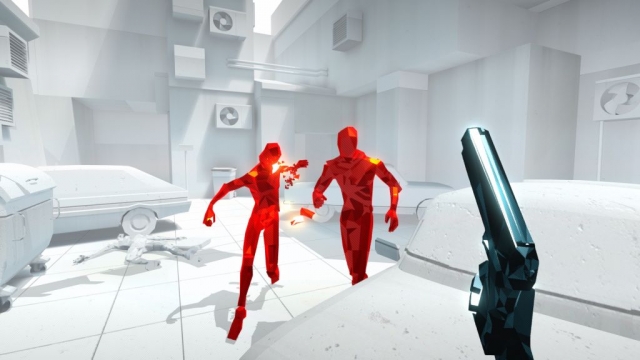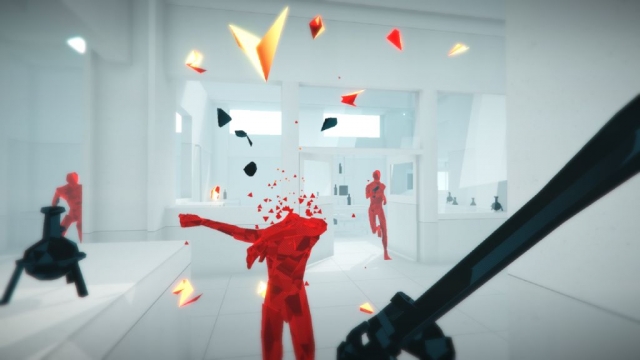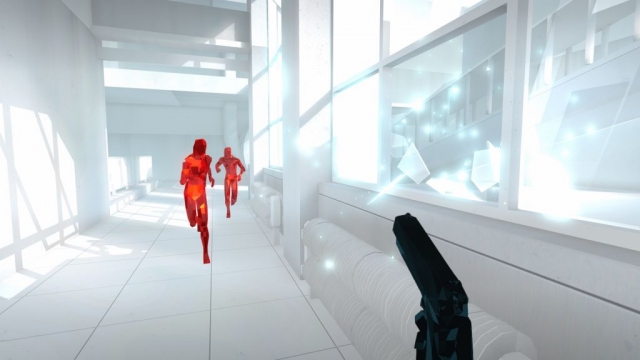Superhot
The Good: Amazing graphical style. Pretty cool gameplay dynamic. Impressive physics engine.
The Bad: Waaaay too short. Ends just as it gets rolling.
The Ugly: Terrible sound effects. Ear-grating load screen sound.
I have to admit, ten minutes into the new hyper-stylized shooter Superhot, I was ready to quit. I was stuck on a mission to run down a long, straight hallway completely unarmed while at the end two red dudes (the game’s one and only bad guy model and, yes, that’s what the game calls them) fired guns down the hallway at me. I had died, I’m not even sure how many times – twenty? Thirty? It was extremely difficult to tell from the character model exactly where the guns were pointing, especially at short range, and that combined with an uncertain hit box (just how much do bullets have to pass me by to guarantee a miss?) and the single-hit insta-death, made the whole affair feel more like a chore than a game. And while I’m not really sure I see a clean path to the solution of that level, I did manage eventually to squeak by it, and beyond I found something entirely unexpected: Superhot is only a shooter in the broadest sense. It’s less FPS and more strategic combat simulator, or perhaps it would be better to call it an FPS puzzler, or best of all simply say that it defies categorization. The issue is further confused by the fact that the “shooter” portion of Superhot is only part of the game within a larger metagame that is a mash up of The Matrix and Ender’s Game, with dashes of Hitman and The Dollhouse thrown in.
Let me back up a little. Superhot on the surface looks like an FPS. The entire world is drawn in shades of white and gray with a very nice level of detail and texture. Enemies are in brilliant red, a little jagged like they’re drawn with a low-ish polygon count, but it works here, and when they’re shot or cut with a sword or beaten with a bat, they smash apart into a shower of pieces. Bullets trace out red ribbons along their trajectories.
The trick, the thing that makes Superhot play not like a shooter, is that time only advances when you move (not strictly true – when you’re not moving time does advance, but at a very, very slow rate – but close enough for government work). This turns the normal twitch gameplay of an FPS into a more strategic activity. You can say to yourself, “well, I’ll cut that red dude with my sword, then throw the sword at that other red dude, take his gun, and shoot those other two…” Then, when you actually put it into action, the instinct to treat the game as an ordinary FPS is immense. I would find myself ducking around a corner to wait for an enemy to come to me, which of course they never will because time stops. Or I would move through it quickly, because I feel as though I need to be fast to, say, get to that red dude before he can pick up that gun and he is moving quickly, but of course I could stop and reconsider, because time stops when I do. That kind of thing.
Layered on top of that are some unique physical rules of this universe, and it takes time to get used to them as well. For example, thrown objects seem to travel faster than bullets. Also, each gun type (there are three: handgun, shotgun, and submachine gun) has a different delay between shots. The submachine gun is essentially instantaneous, the handgun has the longest wait, and the shotgun somewhere in between. It’s really tough to accurately estimate how much to lead a target given the stop-action nature of the universe and the relatively long reset time of the guns. After you fire a shot, you have to wait before you can shoot again, but of course you can’t just wait, because time stops on you. You have to keep moving, and I found myself doing this little side-to-side dance, maybe behind a pillar, waiting for the gun to be ready. Also, characters that are hit by your fist or a weapon or a thrown object, always, I mean 100%, cough up their own weapon, usually in a forward direction. So a very common strategy, if faced by three gunmen, is to shoot the first one, then throw your gun at the second one, even though you’re not out of bullets because you can’t wait for the gun to reset. The guy you hit with your gun, he is stunned and fumbles his own gun, which you can catch. That gun is available to shoot immediately, and you shoot the third guy, and either catch his gun to shoot the second guy, or wait for the gun you have to reset, or throw this gun too at the second guy and then beat him to death with your bare hands.
When you put all of these pieces together in a close-combat action, become a whirling dervish of fists and baseball bats and thrown ashtrays and handguns, the game spools out like an elegant ballet of death, and when you complete a level, the game then plays your solution back to you at normal speed – that looks amazing. But what happens often is more spread out, and my actions consist frequently of little actions design to do nothing other than kill clock cycles, like that side-to-side dance I mentioned earlier, and the playback looks nothing short of spastic.
The metagame takes place in a 1980’s era chatroom – ASCII graphics – which struck a big sentimental chord in me, but probably will mean nothing to anyone under the age of 35. These lead to a level load screen which is an ASCII raster accompanied by an ear-grating whine that was so annoying I turned my sound off. Overall the sounds in the game are bad – muted weapon reports, even breaking glass sounds flat. If there’s any music in the game at all, I don’t recall it. As the conversation in the chat room progresses, the plot that is revealed is interesting. I’ll say nothing more about it to avoid spoilers.
I finished the plotline in Superhot in less than two hours. The game has, I think, twenty-five levels depending on how they are counting them. The first half dozen are tutorial in nature – very short, often emphasizing one small facet of combat. Another ten are related to the metagame, and are not really much like levels you play at all. One has you walk up a staircase, walk down a hall, and bash a guy looking at a computer in the head – that’s it. Several others are very short. There’s one where you kill three guys in an elevator, which takes about ten seconds flat. Towards the end, the last five levels or so are where the metagame and all the other gaming elements finally begin to come together, but then just as you’re starting to get into it, the game is over. After that there are endless play and challenge modes – the same levels as in the game against a clock or using a limited number of weapons – they don’t add much to the overall value. Superhot almost seems like the teaser for a Kickstarter campaign, one that I think I would support, but as a standalone game it is just too thin.
Reviewed By: Phil Soletsky
Publisher: Superhot Team
Rating: 70%
——————————————————————————–
This review is based on a digital copy of Superhot for the PC provided by Superhot Team.
 Game Over Online
Game Over Online
















